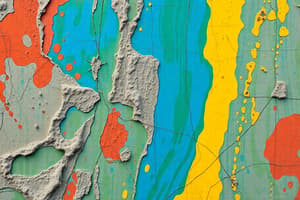Podcast
Questions and Answers
What occurs when cement mixes with water in concrete?
What occurs when cement mixes with water in concrete?
- Interfacial forces between cement paste and aggregate surfaces
- Packing and friction between aggregates
- Chemical reaction between cement and aggregates
- Hydration, producing a calcium silicate hydrate (C-S-H) gel (correct)
What is the primary role of the calcium silicate hydrate (C-S-H) gel in concrete?
What is the primary role of the calcium silicate hydrate (C-S-H) gel in concrete?
- Filling voids between aggregates
- Acting as the 'glue' that binds everything together (correct)
- Creating a chemical bond with aggregates
- Acting as a lubricant between aggregates
What contributes to the mechanical interlocking of aggregates in concrete?
What contributes to the mechanical interlocking of aggregates in concrete?
- Rough surfaces of the aggregates (correct)
- Smooth surfaces of the aggregates
- Chemical reaction between cement and aggregates
- Hydration of cement
What is the primary binding mechanism between aggregates and cement paste in concrete?
What is the primary binding mechanism between aggregates and cement paste in concrete?
What is the role of fine sand particles in concrete?
What is the role of fine sand particles in concrete?
What type of forces are responsible for the slight adhesion between cement paste and aggregate surfaces?
What type of forces are responsible for the slight adhesion between cement paste and aggregate surfaces?
What is not a direct result of the chemical reaction between cement and water?
What is not a direct result of the chemical reaction between cement and water?
What is the ultimate result of the combined effects of mechanical interlocking, packing, and friction in concrete?
What is the ultimate result of the combined effects of mechanical interlocking, packing, and friction in concrete?
What do the rough surfaces of aggregates contribute to in concrete?
What do the rough surfaces of aggregates contribute to in concrete?
Flashcards are hidden until you start studying
Study Notes
Binding of Aggregates with Cement
- Aggregates do not chemically bond with cement particles in concrete, but instead get "stuck" through a physical process.
Cement Hydration
- A chemical reaction called hydration occurs when cement mixes with water.
- Hydration produces a calcium silicate hydrate (C-S-H) gel, which acts as the "glue" that binds everything together in concrete.
Packing and Friction
- Aggregates, particularly fine sand particles, fill the voids between larger coarse aggregates.
- This creates a dense packing where the rough surfaces of aggregates become mechanically interlocked with the hardened C-S-H gel.
- The interlocking shapes of aggregates contribute to a strong mechanical bond.
Interfacial Forces
- Weak attractive forces, such as van der Waals forces, exist between the cement paste (hydrated cement) and aggregate surfaces.
- These forces contribute to a slight adhesion, but are not the primary binding mechanism.
Overall Bonding Mechanism
- The combined effect of mechanical interlocking, dense packing, and weak attractive forces creates a strong bond between aggregates and hardened cement paste.
- This strong bond results in the overall strength and durability of concrete.
Studying That Suits You
Use AI to generate personalized quizzes and flashcards to suit your learning preferences.




